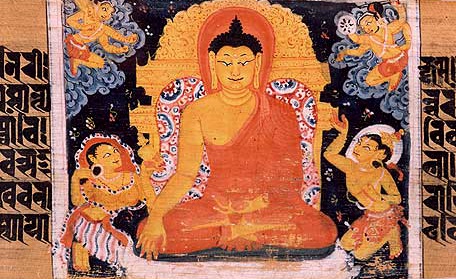|
Ratnasambhava
Ratnasambhava ( sa, रत्नसम्भव, lit. "Jewel-Born") is one of the Five Dhyani Buddhas (or "Five Meditation Buddhas") of Mahayana and Vajrayana or Tantric Buddhism. Ratnasambhava's mandalas and mantras focus on developing equanimity and equality and, in Vajrayana Buddhist thought is associated with the attempt to destroy greed and pride. His consort is Mamaki and his mount is a horse or a pair of lions. Textual History The first documented mention of Ratnasambhava is found in the '' Suvarṇaprabhāsa Sūtra'' and in the Guhyasamāja Tantra (4th Century CE), and he subsequently appears in a number of Vajrayana texts. The most elaborate account of him is to be found in the ''Pañcakara'' section of the ''Advayavajrasaṃgraha.'' In the Śūraṅgama mantra (Chinese: 楞嚴咒; pinyin: ''Léngyán Zhòu'') taught in the Śūraṅgama sutra (Chinese: 楞嚴經; pinyin: ''Léngyán Jīng''), an especially influential dharani in the Chinese Chan tradition, Ratnasambha ... [...More Info...] [...Related Items...] OR: [Wikipedia] [Google] [Baidu] |
Five Tathāgatas
In Mahayana and Vajrayana Buddhism, the Five Tathāgatas (Sanskrit: पञ्चतथागत, ''pañcatathāgata''; ) or Five Wisdom Tathāgatas (), the Five Great Buddhas, the Five Dhyani Buddhas and the Five Jinas (Sanskrit for "conqueror" or "victor"), are five Buddhas which are often venerated together. Various sources provide different names for these Buddhas, though the most common today are: Akshobhya, Ratnasambhava, Vairocana, Amitābha, and Amoghasiddhi. They are sometimes seen as emanations and representations of the five qualities of the Adi-Buddha or "first Buddha", which is associated with the Dharmakāya. Some sources also include this "first Buddha" as a sixth Buddha along with the five. These five Buddhas are a common subject of Vajrayana mandalas and they feature prominently in various Buddhist Tantras. The Five Tathagathas are the primary object of realization and meditation in Shingon Buddhism, a school of Vajarayana Buddhism founded in Japan by Kūkai. I ... [...More Info...] [...Related Items...] OR: [Wikipedia] [Google] [Baidu] |
Śūraṅgama Sūtra
The ''Śūraṅgama Sūtra'' (Sanskrit: शूरङ्गम सूत्र; ) (Taisho 945) is a Mahayana Buddhist sutra that has been especially influential in Chan Buddhism. The general doctrinal outlook of the ''Śūraṅgama Sūtra'' is that of esoteric Buddhism and Buddha-nature, with some influence from Yogacara. There have been questions regarding the translation of this sutra as it was not sponsored by the Imperial Chinese Court and as such the records regarding its translation in the early eighth century were not carefully preserved (see History); however, it has never been classified as apocrypha in any Chinese-language Tripitakas including the Taisho Tripitaka where it is placed in the Esoteric Sutra category (密教部). The sutra was translated into Tibetan during the late eighth to early ninth century and a complete translation exists in Tibetan, Mongolian and the Manchu languages (see Translations). Current consensus is that the text is a compilation of Indic ... [...More Info...] [...Related Items...] OR: [Wikipedia] [Google] [Baidu] |
Guhyasamāja Tantra
The ''Guhyasamāja Tantra'' (Sanskrit: ''Guhyasamājatantra''; Tibetan: ''Gsang ’dus rtsa rgyud'', Toh 442; ''Tantra of the Secret Society or Community''), also known as the ''Tathāgataguhyaka (Secrets of the Tathagata),'' is one of the most important scriptures of Tantric Buddhism, written in Sanskrit. In its fullest form, it consists of seventeen chapters, though a separate "explanatory tantra" (''vyākhyātantra'') known as the ''Later Tantra'' (Sanskrit: Guhyasamāja Uttaratantra; Tibetan: Rgyud phyi ma. (Toh 443)) is sometimes considered to be its eighteenth chapter. Many scholars believe that the original core of the work consisted of the first twelve chapters, with chapters thirteen to seventeen being added later as explanatory material. The ''Guhyasamāja-tantra'' is not to be confused with the Mahayana sutra titled '' Tathāgataguhyaka Sūtra''. In India, it was classified as a Yoga or Mahāyoga Tantra. In Tibet it is considered an Unexcelled Yoga Tantra (''rnal ’ ... [...More Info...] [...Related Items...] OR: [Wikipedia] [Google] [Baidu] |

